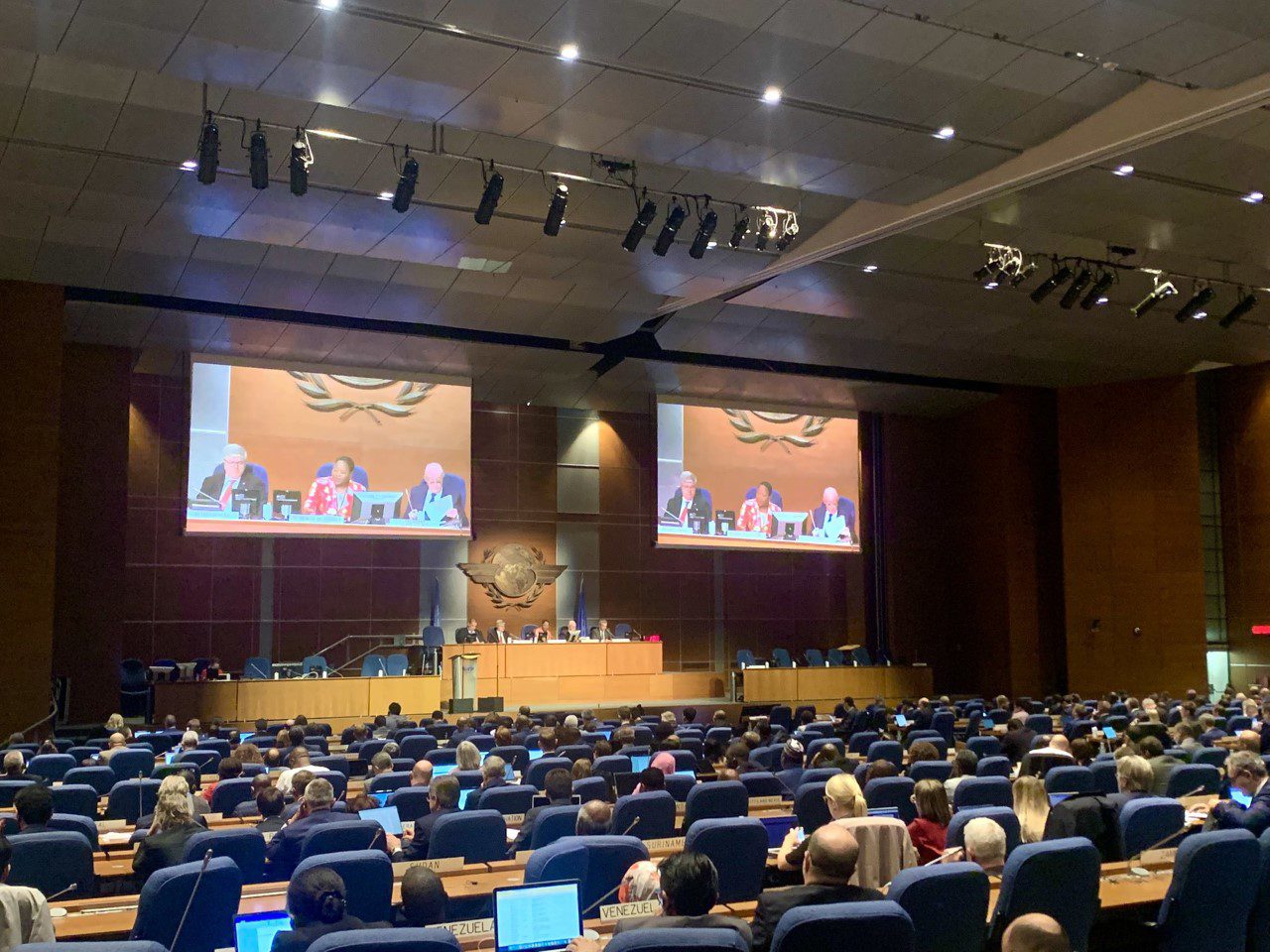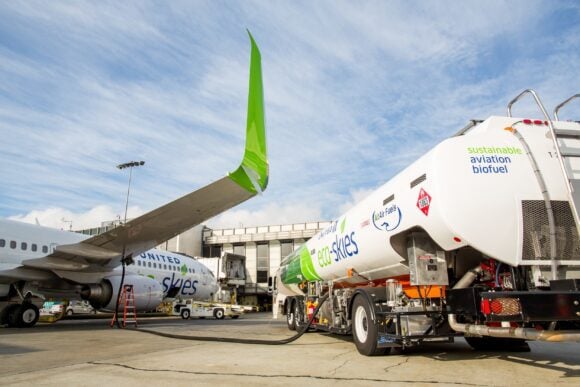
thumbnail IMG 3796
Member states of the International Civil Aviation Organization (ICAO) have almost unanimously agreed on a long-term aspiration goal (LTAG) to get aviation to net zero emissions in 2050. The agreement at the 41st Assembly has been hailed as a success by industry representatives, but environmentalists are critical of an empty goal. ICAO Assembly agrees on net zero roadmap.
The ICAO Assembly agreed on the resolution on the final day of its three-yearly meeting in Montreal, which started on September 27. The main objective has been to reach unanimity between the 193 member states on the roadmap to net zero in 2050. Ahead of the Assembly, stakeholders like IATA and Air Transport Action Group (ATAG) called for clear decisions on two main pillars of the strategy: the CORSIA offsetting scheme and a plan to incentivize the production of sustainable aviation fuels (SAF). While offsetting is seen as a means to compensate for emissions through administrative actions, SAF will have a major role in actually getting to net zero.
The ICAO Assembly, in which 184 countries participated, reinforced its commitment to CORSIA, which is on a voluntary basis until 2027. Much debate was spent on confirming the baseline year for the emission reduction scheme when it enters Phase 1 in 2024. The original plan was to use 2019 and 2020 as baseline years, but IATA and ATAG opposed this idea. In their view, the Covid-year 2020 with very low levels of traffic would reflect unrealistically low carbon emissions. The ICAO Council agreed in August that only 2019 data would be used.
The Assembly agreed today to define 85 percent of emissions from 2019 as the new baseline for CORSIA from 2024. Emissions on international flights above this level need to be offset. Domestic flights are excluded from the program. Revised percentages for sectoral and individual growth factors to calculate offsetting requirements from 2030 were also agreed on.
ICAO Secretary General Juan Carlos Salazar welcomed the outcome of the Assembly: “Countries have achieved some tremendous and very important diplomatic progress at this event, and on topics of crucial importance to the future sustainability of our planet and the air transport system which serves and connects its populations.” Some countries, including China, expressed their concern that carbon-neutral growth from 2020 and the LTAG target of net zero in 2050 will lead to discriminatory market distortions that disadvantage developing countries. China earlier pushed to defer the target to 2060.
Greater cost burden on airlines
IATA has welcomed the agreement on CORSIA. According to Director-General Willie Walsh, “the Assembly’s agreement strengthens CORSIA. The lower baseline will place a significantly greater cost burden on airlines. So, it is more critical than ever that governments do not chip away at the cement which bonds CORSIA as the only economic measure to manage the carbon footprint of international aviation. States must now honor, support and defend CORSIA against any proliferation of economic measures. These will only undermine CORSIA and the collective effort to decarbonize aviation.”
But non-governmental organization Transport & Environment says the outcome of the Assembly is “hugely disappointing”, especially the 85-percent rule of CORSIA. “In its original design, before the watering down by the Assembly, CORSIA was already an ineffective scheme, using cheap offsets with no environmental gains. New calculations by T&E show that with this 85 percent baseline, a mere 22 percent of total international aviation emissions would be covered by the scheme and therefore offset in 2030. The price of offset is so low, that there will be no incentives for the decarbonization of the industry or the uptake of green fuels.”
More work to do on SAF
The long-term aspirational goal calls on individual member states to come up with incentives for the production of SAF and low-carbon aviation fuels (LCAF). While embracing SAF, the Assembly still passed on some homework to the ICAO Council by requesting to actually stimulate the production of SAF, assist states with SAF programs, define and promote the transition to SAF, and facilitate access for states to financing. This is especially important in developing countries in Africa, which mostly lack the resources to fund the infrastructure on their own.
The Assembly also calls on the Council to accelerate the certification of SAF made from new feedstocks. Currently, eleven different procedures have been certified. ICAO should also put its force behind accelerating the certification of 100-percent SAF in commercial engines. Engine makers have demonstrated that they can operate their products with pure SAF, but current regulations allow only a 50/50 percent blend on commercial flights. Another request to member states is to support the delivery infrastructure of SAF at airports. A third ICAO conference on aviation and alternative fuels should address a number of requests and present concrete steps.
Again, IATA welcomed the outcome of the Assembly: “Now that governments and industry are both focused on net zero by 2050, we expect to see much stronger policy initiatives in key areas of decarbonization such as incentivizing the production capacity of SAF. And the global determination to decarbonize aviation that underpins this agreement must follow the delegates home and lead to practical policy actions enabling all states to support industry in the rapid progress that it is committed to make”.
Jan Pie, chair of the International Coordinating Council of Aerospace Industries Associations, said that the agreement on an ambitious climate target “aligns with the industry goal and is a strong signal of leadership in the fight against climate change by the civil aviation sector. As we go forward with new technologies and work to assure 100 percent compatibility of engines and aeroplanes with sustainable fuels, we look forward to working with ICAO to help put those targets into action”.
Haldane Dodd, Executive Director of ATAG, notes that many states will need help with implementing a net-zero pathway. “Financing the transition will be a priority for governments, industry, and the investment sector. And the energy industry will need to get serious about the build-up of sustainable aviation fuels. Net-zero aviation is a significant challenge, but it is fully achievable if we work together across industry, government, the energy sector, and finance communities. Today’s adoption of the long-term goal by ICAO sets a common policy framework at the UN level. We now need individual governments to start working on their own policy environments to complement it.”
IATA’s Willie Walsh also stressed the importance of governments now acting to translate the goals into action. “Governments must not lose the momentum that has driven the outcomes of this assembly. The costs of decarbonizing aviation are in the trillions of dollars and the timeline to transition to a global industry is long. With the right government policies, SAF could reach a tipping point in 2030 that will lead us to our net zero goal.”
Walsh called on ICAO to produce a “clear path of action” at the next Assembly three years from now: “By the next Assembly, the ‘aspirational’ characterization of LTAG must be transformed into a firm goal with a clear plan of action. That means governments must work with industry to implement an effective global policy framework capable of attracting the financial resources needed to put aviation on an unstoppable track to achieve net zero by 2050. There is lots of work to do and not a minute to lose.”
Airbus and Boeing welcome the outcome
On social media, other stakeholders offered their support for the outcome of the Assembly. US Secretary of Transportation, Pete Buttigieg, said on Twitter: “It’s time for aviation to move towards net zero carbon emission in 2050. We’re working with our international partners to make this a reality, and today’s historic agreement is an important step forward.”
Airbus CEO Guillaume Faury said: “This is the sectoral objective we have been striving to obtain: an objective aligned with our ambition for sustainable aerospace. This agreement will enable coherent strategies and accelerate investments. We at Airbus will continue to pioneer to deliver on this ambition.”
Boeing said: “This goal backs up the aviation industry’s ambition to fly net zero and is an important milestone. (…) We asked for a long-term climate goal to be agreed by governments and they have responded. We now need to make it happen, together.”
Airports Council International (ACI) Director-General Luis Felipe de Oliveira called the outcome “a watershed moment in the effort to decarbonize the aviation sector with both governments and industry now heading in the same direction. On a global scale, airports and ACI remain fully committed to reach this net zero goal and we look forward to working together as one aviation ecosystem – so air transport can sustainably deliver socio-economic benefits to people and communities for generations to come”.
Views: 3




